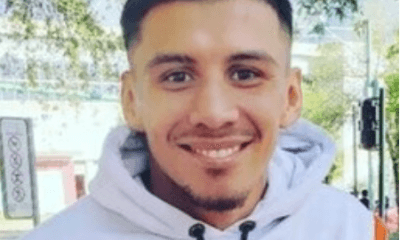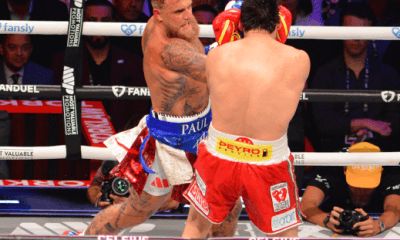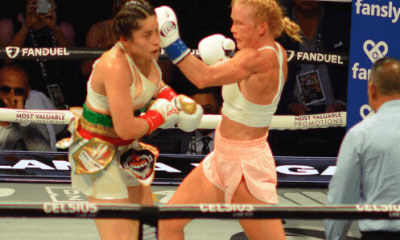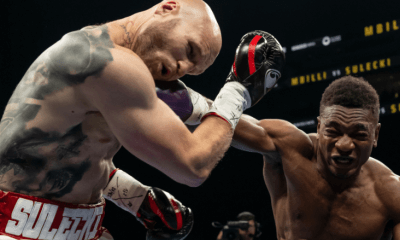Featured Articles
Remembering Prizefighters Danny Nardico and Billy Murray: A Story for Veterans Day
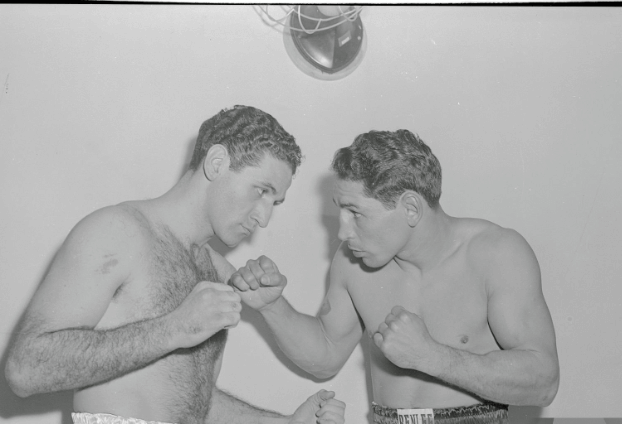
Remembering Prizefighters Danny Nardico and Billy Murray: A Story for Veterans Day
“There are now over 4000 pro boxers in our armed forces” said a story in the Sept. 19, 1943 issue of the Pittsburgh Press. Some of those boxers returned from the battlefields physically unscathed and were able to extend their career. Others were damaged and never fought again and still others never returned.
Among those 4000-plus boxers who served in World War II were two former world champions who would be decorated for their heroism, Barney Ross and Lew Jenkins. Books have been written about them. Here’s a look at two others who were in the thick of that terrible conflagration, stories worth re-telling today, Nov. 11, Veterans Day in the United States, a day set aside to honor all those that served our nation in the military.
Danny Nardico
Danny Nardico (pictured on the right squaring off against 1952 foe Dan Bucceroni) was born in Ohio near Cleveland, the product of a broken home. He was two years old when his father walked out on little Danny and his six siblings.
At age 17, Nardico enlisted in the Marines. He was wounded in the Battle of Gloucester which began on the day after Christmas in 1943 on an island in New Guinea. The Marines were sent there to destroy two Japanese air bases.
Nardico, despite his tender age, was reportedly a squad leader. The bullet he took in his leg did not stop him from participating in other battles in the Pacific theater. For his valor he received a Purple Heart and a Silver Star.
As a professional boxer, Nardico spent 35 months in The Ring Top 10, rising to #3 in the light heavyweight division. He had two signature fights, the first against Jake LaMotta in Miami (actually Coral Gables) on New Year’s Eve, 1952.
Airing on CBS, this was the first nationally televised fight emanating from the state of Florida. Of greater significance, Nardico became the first man to score a knockdown against the rugged LaMotta who was then in the twilight of his career. It happened in round seven, a straight right following a left hook that dropped the Bronx Bull on his pins. Jake survived the round, just barely, and his corner pulled him out before the eighth.
The Ring recognized Nardico’s performance by naming him the Fighter of the Month.
Nardico wasn’t so fortunate in his next memorable fight. On Jan. 20, 1954, he was stopped inside the ninth frame by Charley Norkus, a banger who fought out of Jersey City. Both were in dire straights during this contest, a wild skirmish punctuated by eight knockdowns, six by Norkus. An instant classic, it was named The Ring Fight of the Year. (Danny Nardico, who came in at 181 ½, was out-weighed by 15 ½ pounds. They fought again nine weeks later and Norkus won a unanimous decision in another fierce fight.)
Before his bouts with Charley Norkus, Nardico fought Joey Maxim in a de facto eliminator for Archie Moore’s world title. An outdoor event in Miami, Nardico had Maxim on the canvas in the seventh round but couldn’t sustain the momentum and lost a 10-round decision.
Nardico quit the sport with a record of 50-13-4 (35 KOs) and became a postal worker in Tampa. He later relocated to Sacramento where his second wife, the former Rachel Galindo, had family, and opened an appliance repair shop. When that failed, he accepted a job as the recreation director at the Northern Nevada Correctional Center in Carson City, Nevada, where he and Rachel lived on the grounds of the minimum security prison. After 13 years in the Silver State, he returned to the Sacramento area with Alzheimer’s to live out his days.
Danny and Rachel were married 48 years when Danny passed away at age 85 in 2010. Speaking about her late father, Nardico’s daughter Danella Plum said, “I remember my father being strong as an ox, but tenderhearted….He had a hard exterior, but inside he was as soft as a marshmallow.”
Billy Murray
Stylistically, Billy Murray and Danny Nardico were complete opposites. Murray, who predated Nardico as a fledgling pro by roughly 10 years, was a cutie. Nardico was a brawler who willingly took two punches to land one of his own. But beyond this, both had a great deal in common.
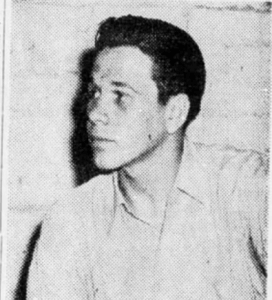
Billy Murray 1941 photo
Both were born in Ohio – Nardico in Painesville and Billy Murray in the blue-collar Ohio River town of Bellaire – and both spent the bulk spent of their professional boxing lives in Tampa. They even had the same trainer, Bill Gore, who would be named to the International Boxing Hall of Fame, in large part because of his work with Willie Pep. And, akin to Nardico, Murray would also be feted as The Ring Fighter of the Month.
Murray, sometimes billed as Irish Billy Murray, was accorded the honor in the July 1941 issue of the self-styled “Bible of Boxing” which hit the newsstands in June. Murray was recognized for his work in the month of May where he scored six wins, upping his ledger to 29-0.
It was the dream of every young boxer to see his name on the marquee at Madison Square Garden. Billy Murray achieved that goal in August of 1942 when he was matched against the formidable Beau Jack.
Murray entered the contest with a 58-2 record, but took the fight on two days’ notice and was a heavy underdog to the former Georgia bootblack. He wound up losing a unanimous decision, but lasting the distance was a feather in his cap and he could look forward to many more engagements at the famous New York sock palace. With Bill Gore piloting his career, he might yet reach the height of stablemate Willie Pep who was then well on his way to getting a world title shot.
Then came the letter from Uncle Sam that so many young men dreaded receiving. Murray was ordered to report for his induction physical. He had been drafted into the Army.
Murray was assigned to the Air Force. He was remanded to Keesler Air Force Base in Biloxi, Mississippi, where he was taught how to be an airplane mechanic and then to gunnery school at Nellis Air Force Base in Las Vegas, Nevada. An Air Force World War II gunner was a crew member on a bomber plane, responsible for protecting the aircraft from machine gun fire by fighting fire with fire.
Billy Murray took his 58-3 record to the grave. On Nov. 24, 1943, the day before Thanksgiving, this terse message appeared in the papers: “Cpl. William F. Murray, better known as Billy Murray was reported missing in action by the War Department.” Murray’s plane had been shot down somewhere over Italy.
Murray learned the rudiments of boxing at a gym in Canonsburg, Pennsylvania, an hour’s drive from Bellaire. “Sports fans and friends of Billy Murray will always remember him and hope that he will turn up to show his wares again when the conflict is over,” read a story in the Canonsburg paper.
But he never did.
News reports do not list Billy Murray’s age but he was undoubtedly in his early twenties. He looks even younger in the few photos of him that can be found in old papers. One is reminded of the famous anti-war poem by the great sportswriter Grantland Rice.
How very young the faces were
Where all the dead men lay
…wrote Rice in the second stanza of his poem which concludes with his observation that “nearly all the dead were hardly more than boys.”
Danny Nardico, who fought in some of the fiercest boxing contests of his generation, once said, “it was all a cakewalk [compared to the War].” Today, Nov. 11, is a federal holiday, a day set aside to recognize the sacrifices of brave men like Danny Nardico and Billy Murray. And to those of you that served in the military, thank you for your service.
To comment on this story in the Fight Forum CLICK HERE
***
A recognized authority on the history of prizefighting and the history of American sports gambling, TSS editor-in-chief Arne K. Lang is the author of five books including “Prizefighting: An American History,” released by McFarland in 2008 and re-released in a paperback edition in 2020.
-
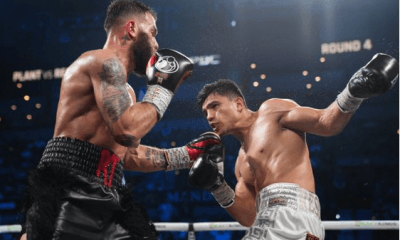
 Featured Articles4 weeks ago
Featured Articles4 weeks agoA Night of Mismatches Turns Topsy-Turvy at Mandalay Bay; Resendiz Shocks Plant
-

 Featured Articles2 weeks ago
Featured Articles2 weeks agoAvila Perspective, Chap. 330: Matchroom in New York plus the Latest on Canelo-Crawford
-

 Featured Articles1 week ago
Featured Articles1 week agoVito Mielnicki Jr Whitewashes Kamil Gardzielik Before the Home Folks in Newark
-
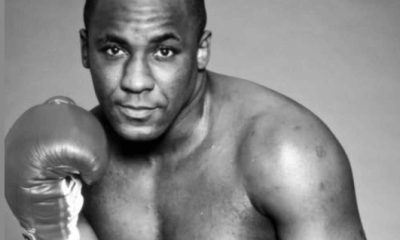
 Featured Articles4 weeks ago
Featured Articles4 weeks agoRemembering the Under-Appreciated “Body Snatcher” Mike McCallum, a Consummate Pro
-

 Featured Articles4 weeks ago
Featured Articles4 weeks agoAvila Perspective, Chap 329: Pacquiao is Back, Fabio in England and More
-

 Featured Articles3 weeks ago
Featured Articles3 weeks agoOpetaia and Nakatani Crush Overmatched Foes, Capping Off a Wild Boxing Weekend
-

 Featured Articles3 weeks ago
Featured Articles3 weeks agoFabio Wardley Comes from Behind to KO Justis Huni
-

 Featured Articles2 weeks ago
Featured Articles2 weeks agoCatching Up with Clay Moyle Who Talks About His Massive Collection of Boxing Books

